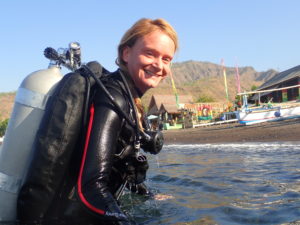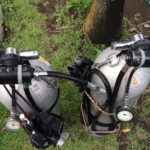Buying recreational diving equipment is both daunting and exhilarating, and it's no different when it comes to technical diving equipment. We took a look at the topic a little while ago, and here we're going to delve a little deeper on how to go about choosing regulators for technical diving.
The basics
As a recreational diver, you may already own a set of regulators. Generally, this consists of a first stage, two second stages — one of which is mounted on a longer hose — a high-pressure hose for your submersible pressure gauge (SPG) and maybe a console plus one or two low-pressure inflator hoses for your BCD and your drysuit, if you're diving in cold waters.
As an open-circuit technical diver, you will be carrying more than one tank, and consequently, you will be using more than one set of regulators. Each set has slightly different components depending on its purpose, but all will consist of a first stage, a second stage and a high-pressure hose with SPG — with one exception we'll get to later in this post.
Which components are part of your individual regulators depends on when you are planning to use them on the dive. Roughly speaking, you can divide tech dives into three phases: the bottom part, travel to and from the bottom part, and the decompression phase.
Bottom or back-gas regulators
Bottom, or 'back-gas,' regulators attach to your twinset or your main sidemount tanks. While the term bottom gas is pretty self-explanatory, 'back-gas' refers to the fact that the twinset containing this gas is usually on your back.
Whether you are diving air, nitrox or trimix, these are the regulators that you will be using during the deepest phase of your dive, when your breathing gas is most dense and therefore hardest to breathe. That means you are looking for high-performance regulators that can deliver a lot of gas to allow you to breathe as easily as possible. Your choice of gas obviously influences breathing ease, but your regs have a role to play as well.
Regulator configuration

The author models twinset configuration on a dive. (Credit Heather Sutton)
If you are diving twinsets, you need a first stage each for your left and right tank, also called left and right post. While there are some variations, most tech divers will have a second stage with a 7-foot (2 m) hose on the right as well as their inflator hose leading to their wing. The long hose connects to the second stage that tech divers generally breathe from. The hose is longer to allow divers to share gas and exit a restriction while swimming behind each other.
The left tank typically holds a second stage on a short regulator hose with a 'necklace' made from bungee cord or surgical tubing, as well as a high-pressure hose and an SPG. There may also be another inflator hose here for a drysuit or the second bladder of the BCD if it has one. The necklace allows the diver to easily reach their second stage in case they need to donate their long hose.
Did you notice there is no SPG on the right post? When diving manifolded (connected) twinset tanks, the diver accesses gas from both tanks through one regulator as long as the manifold isolator valve is open. This means that as long as there is no equipment failure, one SPG is enough.
Sidemount setups

Sidemount setups can vary more as the configuration in general is more individual. One common option, however, is to rig the right tank with a first stage, a second stage on a long hose, and an SPG on a short high-pressure hose, usually about 6 inches (15 cm) long. There may also be an inflator hose for a drysuit or a second BCD bladder here.
On the left tank is a first stage with a second stage attached to a short hose and again equipped with a necklace. Often, there is an angled 'elbow' piece between the second stage and the hose, allowing divers to easily identify which tank they are breathing from. Additionally, there is a short high-pressure hose with an SPG and an inflator hose connecting to the sidemount harness and wing.
Many sidemount divers run their inflator across their body rather than over their shoulder. This means that suitable regulators often have a fifth low-pressure port at a right angle to the other ports. It's also easier to streamline a sidemount setup by using first stages that have the capacity to swivel and therefore allow cleaner hose routing.
Some manufacturers have started offering dedicated twinset and sidemount regulator sets. This is a good way to purchase all the bits and pieces in one go. In the case of twinset regulators for example, they might have low-pressure ports pointing downward at an angle for better hose routing. Sidemount sets will have swiveling first stages with five low-pressure ports, one of which is at a right angle.
Deco regulators
Regulators for the decompression phase of the dive generally feature a first stage, second stage on a somewhat longer hose (octopus length) and an SPG on a short high-pressure hose.
Tech divers use these regulators with oxygen-rich nitrox mixes to help accelerate decompression and, therefore, the units must be suitable for use with oxygen. In practice, this means choosing a regulator that is made of a material with a high flash-point – titanium, for example. The regulator must also be cleaned for oxygen use, and any O-rings and greases used in the process must be oxygen-compatible. Not every regulator will be suitable fresh out of the factory, so it's important to check on this when you are buying your deco regs.
As we generally use these regulators on shallower parts of the dive, we can use unbalanced first stages. However, this is still life-saving equipment, so the general recommendation to buy the highest quality possible while remaining practical.
Travel gas regulators
Trimix divers usually use 'travel gas,' a breathing gas that does not contain enough oxygen to sustain life on land. Their components will often resemble deco regulators, although they may not need to be oxygen-clean depending on the gases the diver uses.
If all that sounds daunting, consider this: you can usually rent equipment for your tech courses from the instructor or shop that is conducting the course. Most budding tech divers qualify initially to dive a twinset or sidemount tanks for the bottom part of the dive and one deco gas, so that's 'only' three regulators. Additionally, you may be able to reconfigure some of the components you already own.
Last, but not least, consider where you will be diving. If you're going to be in cold water, make sure your regs are suitable for that. If you will be spending a lot of time in remote areas, some brands will be easier to maintain than others due to the availability of spare parts and service technicians.
The first step when it comes to choosing regulators for technical diving is to speak to your instructor and other tech divers about what they use. Spend some time researching before going on that shopping spree. One thing is for sure — as your tech diving journey continues, your gear bag will only expand.
The post Choosing Regulators for Technical Diving appeared first on Scuba Diver Life.
from Scuba Diver Life http://bit.ly/2UGTGTu
No comments:
Post a Comment